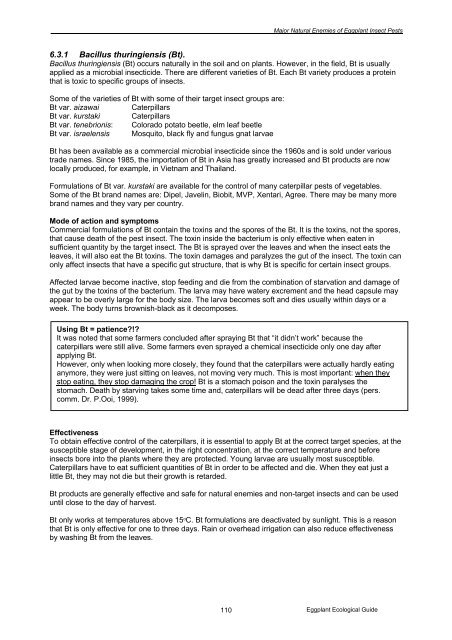Eggplant Integrated Pest Management AN ECOLOGICAL GUIDE
Eggplant Integrated Pest Management AN ECOLOGICAL GUIDE
Eggplant Integrated Pest Management AN ECOLOGICAL GUIDE
Create successful ePaper yourself
Turn your PDF publications into a flip-book with our unique Google optimized e-Paper software.
__________________________________________________________________Major Natural Enemies of <strong>Eggplant</strong> Insect <strong>Pest</strong>s6.3.1 Bacillus thuringiensis (Bt).Bacillus thuringiensis (Bt) occurs naturally in the soil and on plants. However, in the field, Bt is usuallyapplied as a microbial insecticide. There are different varieties of Bt. Each Bt variety produces a proteinthat is toxic to specific groups of insects.Some of the varieties of Bt with some of their target insect groups are:Bt var. aizawai CaterpillarsBt var. kurstaki CaterpillarsBt var. tenebrionis: Colorado potato beetle, elm leaf beetleBt var. israelensis Mosquito, black fly and fungus gnat larvaeBt has been available as a commercial microbial insecticide since the 1960s and is sold under varioustrade names. Since 1985, the importation of Bt in Asia has greatly increased and Bt products are nowlocally produced, for example, in Vietnam and Thailand.Formulations of Bt var. kurstaki are available for the control of many caterpillar pests of vegetables.Some of the Bt brand names are: Dipel, Javelin, Biobit, MVP, Xentari, Agree. There may be many morebrand names and they vary per country.Mode of action and symptomsCommercial formulations of Bt contain the toxins and the spores of the Bt. It is the toxins, not the spores,that cause death of the pest insect. The toxin inside the bacterium is only effective when eaten insufficient quantity by the target insect. The Bt is sprayed over the leaves and when the insect eats theleaves, it will also eat the Bt toxins. The toxin damages and paralyzes the gut of the insect. The toxin canonly affect insects that have a specific gut structure, that is why Bt is specific for certain insect groups.Affected larvae become inactive, stop feeding and die from the combination of starvation and damage ofthe gut by the toxins of the bacterium. The larva may have watery excrement and the head capsule mayappear to be overly large for the body size. The larva becomes soft and dies usually within days or aweek. The body turns brownish-black as it decomposes.Using Bt = patience?!?It was noted that some farmers concluded after spraying Bt that “it didn’t work” because thecaterpillars were still alive. Some farmers even sprayed a chemical insecticide only one day afterapplying Bt.However, only when looking more closely, they found that the caterpillars were actually hardly eatinganymore, they were just sitting on leaves, not moving very much. This is most important: when theystop eating, they stop damaging the crop! Bt is a stomach poison and the toxin paralyses thestomach. Death by starving takes some time and, caterpillars will be dead after three days (pers.comm. Dr. P.Ooi, 1999).EffectivenessTo obtain effective control of the caterpillars, it is essential to apply Bt at the correct target species, at thesusceptible stage of development, in the right concentration, at the correct temperature and beforeinsects bore into the plants where they are protected. Young larvae are usually most susceptible.Caterpillars have to eat sufficient quantities of Bt in order to be affected and die. When they eat just alittle Bt, they may not die but their growth is retarded.Bt products are generally effective and safe for natural enemies and non-target insects and can be useduntil close to the day of harvest.Bt only works at temperatures above 15 o C. Bt formulations are deactivated by sunlight. This is a reasonthat Bt is only effective for one to three days. Rain or overhead irrigation can also reduce effectivenessby washing Bt from the leaves.110<strong>Eggplant</strong> Ecological Guide




![Section 4 [ PDF file, 252 KB] - The Field Alliance](https://img.yumpu.com/51387260/1/158x260/section-4-pdf-file-252-kb-the-field-alliance.jpg?quality=85)











